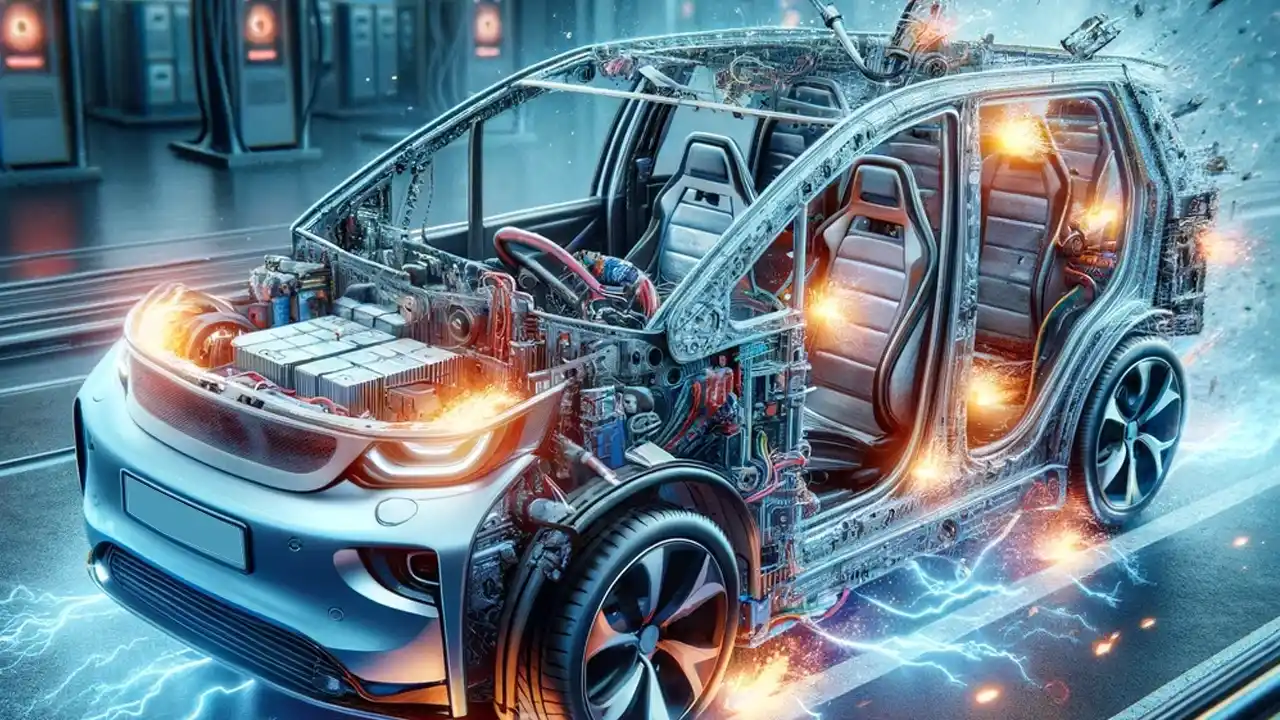Home »
In recent years, the rise of electric vehicles (EVs) has marked a significant transition towards sustainable transportation. However, alongside the environmental benefits and technological advancements, concerns about the safety of electric vehicles have also surfaced, particularly regarding the risk of fire incidents. While electric vehicles offer numerous advantages over traditional internal combustion engine vehicles, the unique characteristics of their batteries and electrical systems introduce new challenges and potential hazards. This essay explores the various technical, environmental, and operational aspects that contribute to electric car fires, delving into the complex causes of these accidents.
Top 6 Reasons Why Electric Vehicle Catches Fire
1. Battery Chemistry and Thermal Runaway
Lithium-ion batteries, which are well known for their high energy density and suitability for electric propulsion, are the brains of electric cars. Lithium-ion battery efficiency, however, comes with inherent dangers due to the chemistry itself. One of the main issues with EV safety is thermal runaway, a phenomenon marked by uncontrollably high heat generation and battery cell breakdown.
Lithium-ion batteries consist of multiple cells interconnected to form a battery pack. One or more cells may experience thermal runaway under specific circumstances, such as overcharging, external damage, or internal faults. It can start a chain reaction that quickly spreads to other cells. The high energy density of lithium-ion batteries means that thermal runaway can lead to intense fires that are challenging to contain and extinguish.
2. Impact and Mechanical Damage
Another significant risk factor for electric vehicle fires is impact and mechanical damage. Like their traditional counterparts, electric vehicles are prone to crashes and mishaps. However, because EVs use high-voltage electrical systems and battery packs, the effects of an impact may be more severe.
In the event of a crash or collision, the structural integrity of the battery pack may be compromised, leading to punctures, ruptures, or short circuits within the cells. Even minor damage to the battery enclosure can expose sensitive components to external elements, increasing the likelihood of thermal runaway and fire initiation.
3. Manufacturing Defects and Quality Control
Defects and quality control problems continue to be a recurring problem in the manufacture of electric vehicles, even with advances in battery technology and manufacturing techniques. Inadequate quality control measures or oversight during manufacturing can result in subtle defects or anomalies within battery cells and electrical components, increasing the likelihood of malfunctions and fire incidents.
Even minor deviations in the composition of battery materials or inconsistencies in assembly procedures can compromise the safety and reliability of lithium-ion batteries. Defects such as internal shorts, dendrite formation, or electrolyte leakage can escalate into critical failures under operational conditions, leading to thermal runaway and fires.
4. Overcharging and Thermal Management
Effective thermal management is crucial to keep lithium-ion batteries within their ideal working temperature range and avoid thermal runaway situations. Overcharging, a condition where the battery is subjected to excessive voltage or current during charging, can accelerate the degradation of battery cells and elevate the risk of fire.
- Audi GT50 Concept: A Loud Reminder of Why Car Enthusiasts Fell in Love With Audi
- Nearly 30% of UK Drivers Believe Car Tax Should Be Based on Mileage — Survey
- Why Planes and Boats Escaped the Luxury Tax But Cars Didn’t
- Australia’s Headlight Confusion: Authorities Warn Drivers After Viral $250 Headlight Rule Goes Wild Online
- 2025 Hyundai Venue Facelift Launched in India – Full Details, Variants, and Price
Inadequate thermal management systems or charging infrastructure may exacerbate the risks associated with overcharging, particularly in fast-charging scenarios where higher currents are employed to reduce charging times. Prolonged exposure to elevated temperatures can compromise the stability of battery materials and promote the onset of thermal runaway, posing significant safety hazards to vehicle occupants and surrounding environments.
5. External Environmental Factors
Beyond internal factors, external environmental conditions and externalities can also contribute to the occurrence of electric vehicle fires. Extreme temperatures, humidity levels, and exposure to corrosive substances can affect the performance and integrity of battery cells and electrical components, potentially triggering thermal runaway events.
Moreover, environmental factors such as exposure to water or moisture, especially in flood-prone regions or during severe weather events, can compromise the insulation and electrical isolation of high-voltage components, increasing the susceptibility of electric vehicles to short circuits and electrical faults.
6. Electrical System Malfunctions and Wiring Issues
The complex electrical architecture of electric vehicles comprises numerous components, including wiring harnesses, connectors, and control modules, which are susceptible to malfunctions and electrical faults. Wiring issues such as insulation degradation, chafing, or improper installation can lead to short circuits or electrical arcing, generating heat and igniting nearby flammable materials.
Additionally, electronic control units responsible for monitoring and regulating the operation of electric drivetrains and battery systems may be susceptible to software glitches or hardware failures, compromising the overall safety and reliability of electric vehicles.
In conclusion, several factors, including battery chemistry, vehicle design, manufacturing procedures, and operational concerns, can affect the likelihood of fire events in electric vehicles. While the transition towards electric mobility offers numerous environmental and societal benefits, addressing the safety challenges associated with electric vehicles requires a holistic approach encompassing rigorous quality control measures, advanced thermal management systems, and robust regulatory frameworks.
Stakeholders in the automotive industry can work together to develop creative solutions and reduce risks by comprehending the underlying causes and contributing factors of electric vehicle fires. It will ensure the safe and sustainable advancement and adoption of electric transportation.
